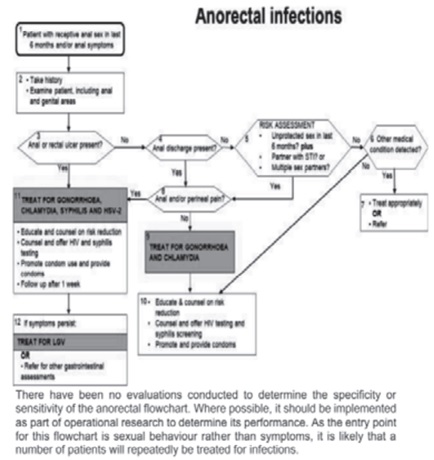Anal And Rectal Infections
exp date isn't null, but text field is
Anorectal symptoms and sexually transmitted anorectal infections are prevalent in men who have sex with men (MSM), in female sex workers, transgendered and heterosexual individuals who practice anal sexual intercourse.
Anatomical sites of infection
Infections of the ano-rectal region can be divided into the following anatomical sites:
- Anal infections: infections of the external anus and anal canal, involving the stratified squamous epithelium - a common site for pathogens such as the human papillomavirus (HPV), herpes simplex virus (HSV) and syphilis;
- Proctitis: infections from the dentate line to the rectosigmoid junction - a common site for gonococcal and chlamydial infections and HSV (the dentate line is the line between the simple columnar epithelium and the stratified epithelium of the anal canal, usually defined as being at the level of the anal valves;
- Proctocolitis; infections of the rectum and colon - a common site for Shigella, Campylobacter, Salmonella, cytomegalovirus and amoebiasis.
For syndromic diagnosis and management, these infections can be grouped under ano-rectal infections. Anorectal infections may be associated with anorectal pain, itching, discharge, bleeding, sensation of rectal fullness, tenesmus, constipation, and mucus streaking of stools. However, more frequently, ano-rectal infections tend to be asymptomatic.
An examination for anal infections includes an external examination of the anus and a proctoscopy examination. In the absence of a proctoscope, as is the case in most primary point-of-care settings, an external examination of the anus may be the only practical procedure to observe a discharge, ulcers or external warts.
If painful perianal ulcers are reported and observed, or mucosal ulcers are noted on proctoscopy, treatment should include a regimen for genital herpes and syphilis as if following the genital ulcer disease (GUD) flowchart. If ulcers persist, LGV must be considered and managed accordingly.
Thus, in implementing a flowchart for the management of anorectal infections, the following should be taken into consideration:
- identification of persons at risk
- identification of risk behaviours for rectal infection in persons at risk
- proctoscopy skills (and availability of a proctoscope)
- differentiation between anorectal infection and other pathology
- entry points for the management protocol, and
- thresholds for adding treatment for HSV, LGV or syphilis.
Treatment Recommendations for Ano-Rectal Infections
This flowchart guides through the management process for persons practicing anal sex, be they heterosexual or MSM. The choice of medicines, dosage and duration of treatment are, in general, not different from those for infections at other anatomical sites.


